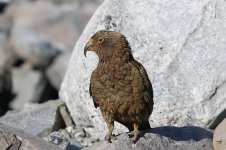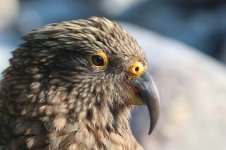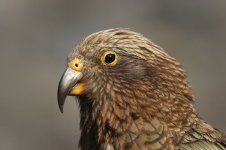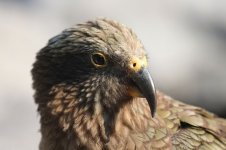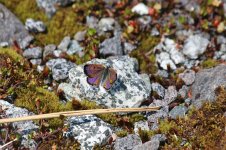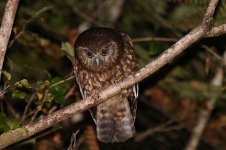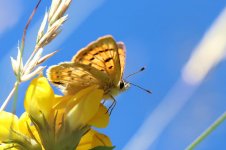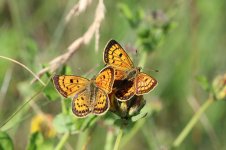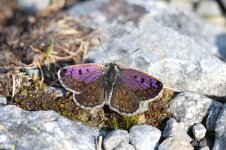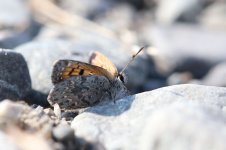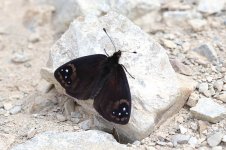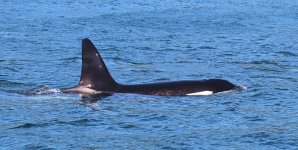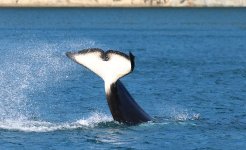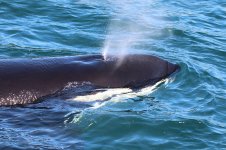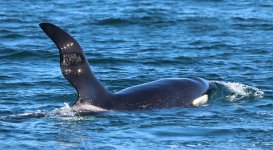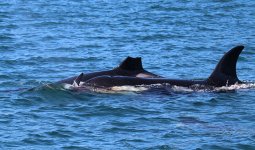-
Welcome to BirdForum, the internet's largest birding community with thousands of members from all over the world. The forums are dedicated to wild birds, birding, binoculars and equipment and all that goes with it.
Please register for an account to take part in the discussions in the forum, post your pictures in the gallery and more.
You are using an out of date browser. It may not display this or other websites correctly.
You should upgrade or use an alternative browser.
You should upgrade or use an alternative browser.
New Zealand, the Final Frontier, 2019-2020 (1 Viewer)
- Thread starter Jos Stratford
- Start date
More options
Who Replied?
31 December. Homer Tunnel.
Fantastic day - cracking weather (sun and up to 32 C) and amazing birds. An initial shock at Homer Tunnel however - in the exact area favoured by Rock Wrens, very prominent signs declared the area closed due to rockfall risk, all parking and walking prohibited. Given there are really no other easily accessible localities for this species in New Zealand, I pondered my options and decided the best would be to park a few hundred metres further down, then access the slopes on the opposite side - an amazing landscape of snow-capped peaks and rugged scree slopes, richly dotted in boulders.
A half hour or so of scrambling, then loud piercing calls echoing across the slopes - I knew what that had to be, Kea! And indeed it was, four flying around over boulder fields a little higher. I started to hike up towards them ...but then they spotted me! And all four promptly flew down to meet me, landing on large boulders just metres away, calling loudly. As I admired them, they hopped from rock to rock, approaching ever closer. And then their intention became clear - they wanted my shoes! They boldly approached and attempted to pull the rubber from the soles of the shoes upon my feet - I was being mugged by mountain parrots with oversized beaks!
Kea encounters over, I turned my thoughts to Rock Wren. By chance, two other birders appeared on the slope at this moment, folks I had also met on Stewart Island, and they had just seen Rock Wren. Excellent, tracked back to where they had seen the birds and, in not much time at all, one classic Rock Wren was on show - darting from boulder to boulder, a splendid fellow indeed.
As for the rest of the day, I also had the idea to find one very localised endemic butterfly that should be on these very same slopes - the West Alpine Boulder Copper. Spent many hours in my endeavour, and ended up finding three pairs of Rock Wrens in the process, including a pair feeding young at the nest. As for the butterfly, I had success too – only a single individual,but a nice male West Alpine Boulder Copper active on a pebbly area in a dry stream bed, always landing on stones to sun itself.
A little later, I did consider taking a cruise in Milford Sound, but seeing the port area was heaving with tourists, and knowing the very low likelihood of Fjordland Crested Penguin at this season, I soon changed my mind and instead began the long drive north. Stopped and camped near Haast.
Fantastic day - cracking weather (sun and up to 32 C) and amazing birds. An initial shock at Homer Tunnel however - in the exact area favoured by Rock Wrens, very prominent signs declared the area closed due to rockfall risk, all parking and walking prohibited. Given there are really no other easily accessible localities for this species in New Zealand, I pondered my options and decided the best would be to park a few hundred metres further down, then access the slopes on the opposite side - an amazing landscape of snow-capped peaks and rugged scree slopes, richly dotted in boulders.
A half hour or so of scrambling, then loud piercing calls echoing across the slopes - I knew what that had to be, Kea! And indeed it was, four flying around over boulder fields a little higher. I started to hike up towards them ...but then they spotted me! And all four promptly flew down to meet me, landing on large boulders just metres away, calling loudly. As I admired them, they hopped from rock to rock, approaching ever closer. And then their intention became clear - they wanted my shoes! They boldly approached and attempted to pull the rubber from the soles of the shoes upon my feet - I was being mugged by mountain parrots with oversized beaks!
Kea encounters over, I turned my thoughts to Rock Wren. By chance, two other birders appeared on the slope at this moment, folks I had also met on Stewart Island, and they had just seen Rock Wren. Excellent, tracked back to where they had seen the birds and, in not much time at all, one classic Rock Wren was on show - darting from boulder to boulder, a splendid fellow indeed.
As for the rest of the day, I also had the idea to find one very localised endemic butterfly that should be on these very same slopes - the West Alpine Boulder Copper. Spent many hours in my endeavour, and ended up finding three pairs of Rock Wrens in the process, including a pair feeding young at the nest. As for the butterfly, I had success too – only a single individual,but a nice male West Alpine Boulder Copper active on a pebbly area in a dry stream bed, always landing on stones to sun itself.
A little later, I did consider taking a cruise in Milford Sound, but seeing the port area was heaving with tourists, and knowing the very low likelihood of Fjordland Crested Penguin at this season, I soon changed my mind and instead began the long drive north. Stopped and camped near Haast.




LOL cheeky wee devils!!

1 January. Munro Beach & Okarito.
New Year's Day, mini attempt for a big day total - didn't do too badly for New Zealand, seeing 52 species in a limited amount of habitat diversity.
Moreover, also had hopes for two particular species - Fjordland Crested Penguin and Okarito Kiwi. Of these, the first is generally out to sea from December to mid-January, so didn't have big expectations, while the second, though globally endangered with a world population of just 350 or so, is relatively easy to see.
So, dawn of the year 2020, Munro Beach, high cloud, calm sea. And not a penguin to be seen! Still, what with White-capped Albatross and Westland Petrel offshore, plus New Zealand Dotterel and Variable Oystercatchers on the beach, it wasn't a bad way to start the year. After ascertaining there really were no Fjordland Crested Penguins lurking in the bay, I explored the neighbouring forest a little, thick luxuriant woodland with abundant ferns and moss, a couple of Kaka making a racket, Tui and Silvereyes common, several New Zealand Fantails and South Island Tomtits adding to the native mix.
From here, I continued north through a mosaic of forestland and pasture, adding abundant open country birds such as Australasian Swamphen, Masked Lapwing and Sacred Kingfishers before finally arriving at Okarito about midday. Strong smell of smoke and offshore haze ... from 2000 km distant, the effects of the Australian fires had reached New Zealand! Simultaneously this day, Auckland experienced orange skies and the Fox Glacier turned a caramel brown.
At Okarito, my goal was the nocturnal Okarito Kiwi, so with hours to kill, I ignored the smell of smoke and explored the coastline and vast Okarito Lagoon as best I could. Best way is to rent a canoe, but sticking to land I still did okay - Banded Dotterel and South Island Oystercatchers on the beach, Caspian Terns and a Black-billed Gull at the rivermouth (along with Kelp and Red-billed Gulls and White-fronted Terns), Fernbirds on a small marsh. As for Okarito Lagoon, ten Eastern White Egrets (best place in New Zealand for this species), hundreds of Black Swans and a good bunch of common ducks and waders.
Then, decided to check out the area in which I would be seeking Okarito Kiwi in a few hours - 6 km inland, the road section near the entrance to the Pakihi Walk is generally thought to be productive. Not bad forest, Grey Warblers, South Island Tomtits and three South Island Robins along the walk, as well as New Zealand Pigeons et al. Better however, a nice grassy track adjacent to the road that seemed perfect for kiwis, plus broad grassy verges to the road itself.
Finally darkness arrived, Moreporks calling as dusk descended, two soon showing exceptionally well. Kitted out with red torch and a good dose of patience, I began my kiwi search - nothing on the grassy track, bar another very cooperative Morepork, so I turned to the road. Concentrated on the half kilometre below Pakihi Walk, basically adopting the strategy of standing in total darkness and silence waiting for one to hopefully approach. Perhaps a half hour of this and a bit of rustling in the depths of the darkness, undoubtedly a kiwi on the prowl. Art here was to suppress the urge to flick on the torch, but instead to wait in the pitch black until it was probably in a position that it could be seen. Fifteen minutes more of sporadic rustles, but not a single squeak, then the bird was clearly emerging onto the verge …flicked on the red light, Okarito Kiwi in full view, a female stretching up to peer at this human intruder. Back into the vegetation it went. A few minutes later, back out onto the verge it came, thereafter trotting across the road, its oversize feet plodding right past me. Thereafter, for 50 metres or so, it slowly wandered down the verge, feeding quite content and showing very well.
Fifteen minutes to midnight, an excellent end to the first day of the year. Camped at the DOC site near the main road junction.
New Year's Day, mini attempt for a big day total - didn't do too badly for New Zealand, seeing 52 species in a limited amount of habitat diversity.
Moreover, also had hopes for two particular species - Fjordland Crested Penguin and Okarito Kiwi. Of these, the first is generally out to sea from December to mid-January, so didn't have big expectations, while the second, though globally endangered with a world population of just 350 or so, is relatively easy to see.
So, dawn of the year 2020, Munro Beach, high cloud, calm sea. And not a penguin to be seen! Still, what with White-capped Albatross and Westland Petrel offshore, plus New Zealand Dotterel and Variable Oystercatchers on the beach, it wasn't a bad way to start the year. After ascertaining there really were no Fjordland Crested Penguins lurking in the bay, I explored the neighbouring forest a little, thick luxuriant woodland with abundant ferns and moss, a couple of Kaka making a racket, Tui and Silvereyes common, several New Zealand Fantails and South Island Tomtits adding to the native mix.
From here, I continued north through a mosaic of forestland and pasture, adding abundant open country birds such as Australasian Swamphen, Masked Lapwing and Sacred Kingfishers before finally arriving at Okarito about midday. Strong smell of smoke and offshore haze ... from 2000 km distant, the effects of the Australian fires had reached New Zealand! Simultaneously this day, Auckland experienced orange skies and the Fox Glacier turned a caramel brown.
At Okarito, my goal was the nocturnal Okarito Kiwi, so with hours to kill, I ignored the smell of smoke and explored the coastline and vast Okarito Lagoon as best I could. Best way is to rent a canoe, but sticking to land I still did okay - Banded Dotterel and South Island Oystercatchers on the beach, Caspian Terns and a Black-billed Gull at the rivermouth (along with Kelp and Red-billed Gulls and White-fronted Terns), Fernbirds on a small marsh. As for Okarito Lagoon, ten Eastern White Egrets (best place in New Zealand for this species), hundreds of Black Swans and a good bunch of common ducks and waders.
Then, decided to check out the area in which I would be seeking Okarito Kiwi in a few hours - 6 km inland, the road section near the entrance to the Pakihi Walk is generally thought to be productive. Not bad forest, Grey Warblers, South Island Tomtits and three South Island Robins along the walk, as well as New Zealand Pigeons et al. Better however, a nice grassy track adjacent to the road that seemed perfect for kiwis, plus broad grassy verges to the road itself.
Finally darkness arrived, Moreporks calling as dusk descended, two soon showing exceptionally well. Kitted out with red torch and a good dose of patience, I began my kiwi search - nothing on the grassy track, bar another very cooperative Morepork, so I turned to the road. Concentrated on the half kilometre below Pakihi Walk, basically adopting the strategy of standing in total darkness and silence waiting for one to hopefully approach. Perhaps a half hour of this and a bit of rustling in the depths of the darkness, undoubtedly a kiwi on the prowl. Art here was to suppress the urge to flick on the torch, but instead to wait in the pitch black until it was probably in a position that it could be seen. Fifteen minutes more of sporadic rustles, but not a single squeak, then the bird was clearly emerging onto the verge …flicked on the red light, Okarito Kiwi in full view, a female stretching up to peer at this human intruder. Back into the vegetation it went. A few minutes later, back out onto the verge it came, thereafter trotting across the road, its oversize feet plodding right past me. Thereafter, for 50 metres or so, it slowly wandered down the verge, feeding quite content and showing very well.
Fifteen minutes to midnight, an excellent end to the first day of the year. Camped at the DOC site near the main road junction.


Need to finish this thread 

2 January. Arthur's Pass.
Shifted 220 km with the plan to search for three endemic butterflies around Arthur's Pass this day. Rain however effectively cancelled that - a near write-off day, drizzle alternating with heavy downpours almost right through. Two soggy Keas near my parked car, one bedraggled South Island Robin, about the best of the day.
Near 5 pm however, suddenly blue skies and a picture perfect evening, warm and sunny. A bit late for butterflies, but I did indeed find one of my targets - along with a couple of Coastal Coppers, there were also four Canterbury Alpine Boulder Coppers, these tiny little butterflies most exquisite.
Capped off the evening with an attempt on Great Spotted Kiwi - now probably with eggs or young chicks, I didn't even hear one. My expectation to not see this species was correct!
3 January. Cheeseman Mountain and the Canterbury Area.
Woke to perfect butterfly conditions - warm sun and no wind. With a cap of cloud over Arthur's Pass itself, I dropped 30 km to the west and took a gravel road up to a ski area below Mount Cheeseman. Great habitat for my two targets - large patches of snow tussock at 900 m altitude for Janita's Tussock, then high scree areas at 1400-1500 m for Black Mountain Ringlet.
A very pleasing hour or so at the lower site, plentiful Canterbury Alpine Boulder Coppers sunning on tracks and rocks, a couple of Coastal Coppers, then as it warmed a little, the first of several tussock butterflies - weak fliers, but very mobile nonetheless. Were they Common or Janita's Tussock? At this altitude, they should be Janita's Tussock, and as I finally saw several settle, indeed they were! Pronounced veins on the upper wings, a lack of silver edging to the underwing streaks - distinctive features.
So, with those seen, up to the higher altitudes I went for Black Mountain Ringlet. A specialist of scree slopes, this one took a bit more searching. A half hour or so following a zigzag track up the mountain, then a first moving blackish butterfly zipping over the scree. A bit of a scramble on my part, but there he was - Black Mountain Ringlet. A faster mover on scree than me, no photographs however.
A second was rather more cooperative, kindly landing right at the track's edge - a nice butterfly. Also at this altitude, had a few more Canterbury Alpine Boulder Coppers and a couple more Janita's Tussocks, but all too soon clouds began to blot the blue skies.
By 2 pm, the show was over - cloud cover and then drizzle precluding any further butterfly action. Still, I had found the main species that I wanted, so then decided to head down to coastal areas near Canterbury. South of Canterbury, I have to admit to detouring to twitch Mute Swans on Cooper's Lagoon (finding a flock of 36), then I spent the remainder of the afternoon at two localities north of Canterbury in wasted attempts to find Cape Barren Goose, another rare but introduced species. At site 1, sewage settling pools that were difficult to actually observe, I did get a Baillon's Crake, while site 2, the Travis Wetland Park, was pretty birdy overall, but produced nothing new.
As darkness fell, I began a night drive towards Lewis Pass, got about two-thirds of the way and called it a night, camping roadside.
4 January. Lewis Pass.
Another butterfly day, or at least that's what I had planned ...it turned out rather weather challenged again. Targets were Harris's Tussock and Butler's Ringlet, both high altitude range-restricted species. My chosen spot looked quite close to the road on the map, what I hadn't appreciated however was the vertical distance - it was a hard 2.5 hour slog up the side of a mountain to get to the desired grasslands! Couldn't complain too much though - in the moss-laden dwarf forest en route up, a whole bunch of interesting birds, not least 15 or so Rifleman, several Brown Creepers, a single South Island Tomtit and lots off Grey Warblers, New Zealand Bellbirds and Silvereyes.
Having climbed under grey skies and strong winds, I had few thoughts of finding butterflies when I finally reached the grasslands flanking the summit. Miraculously, the clouds did break just as I reached the top, a moderately pleasant sun appearing. That said, the winds never abated and it remained pretty cold, thus I explored the more in hope than expectation. Almost immediately, however, I was rewarded for my effort - not a butterfly, but several pairs of New Zealand Pipits, a bird that had been eluding me all trip! At least six in total, these would remain the only ones I would see on the trip.
As for butterflies, I saw a grand total of one individual - a fast moving dark butterfly that I initially assumed would be a Butler's Ringlet. Alas no, after I chased it across the grassland, it settled and revealed its identity - an out-of-habitat Black Mountain Ringlet, the species I had found the day before!
Clambered back down the mountain, drove west for 2.5 hours, arriving a couple of hours before dark. Perfect timing, I started by admiring gathering Westland Petrels off Pancake Rocks (also admiring three Wekas and the impressive geological formations and sea funnels), then headed up the nearby Bullock Creek Road for another attempt on Great Spotted Kiwi. A badly damaged road by recent floods and officially closed, I nevertheless got the end and waited for dark, roosting Kaka making quite some noise. As for Great Spotted Kiwi, I was somewhat more successful than at Arthur's Pass, in as much as I heard a single calling at some distance, but equally unsuccessful in as much as nothing seen.
To be honest however, I only gave it a half-hearted attempt - I was slightly worried that it might rain and flood the already washed-out road, so I pretty soon backtracked, drove to Westport and camped.
Shifted 220 km with the plan to search for three endemic butterflies around Arthur's Pass this day. Rain however effectively cancelled that - a near write-off day, drizzle alternating with heavy downpours almost right through. Two soggy Keas near my parked car, one bedraggled South Island Robin, about the best of the day.
Near 5 pm however, suddenly blue skies and a picture perfect evening, warm and sunny. A bit late for butterflies, but I did indeed find one of my targets - along with a couple of Coastal Coppers, there were also four Canterbury Alpine Boulder Coppers, these tiny little butterflies most exquisite.
Capped off the evening with an attempt on Great Spotted Kiwi - now probably with eggs or young chicks, I didn't even hear one. My expectation to not see this species was correct!
3 January. Cheeseman Mountain and the Canterbury Area.
Woke to perfect butterfly conditions - warm sun and no wind. With a cap of cloud over Arthur's Pass itself, I dropped 30 km to the west and took a gravel road up to a ski area below Mount Cheeseman. Great habitat for my two targets - large patches of snow tussock at 900 m altitude for Janita's Tussock, then high scree areas at 1400-1500 m for Black Mountain Ringlet.
A very pleasing hour or so at the lower site, plentiful Canterbury Alpine Boulder Coppers sunning on tracks and rocks, a couple of Coastal Coppers, then as it warmed a little, the first of several tussock butterflies - weak fliers, but very mobile nonetheless. Were they Common or Janita's Tussock? At this altitude, they should be Janita's Tussock, and as I finally saw several settle, indeed they were! Pronounced veins on the upper wings, a lack of silver edging to the underwing streaks - distinctive features.
So, with those seen, up to the higher altitudes I went for Black Mountain Ringlet. A specialist of scree slopes, this one took a bit more searching. A half hour or so following a zigzag track up the mountain, then a first moving blackish butterfly zipping over the scree. A bit of a scramble on my part, but there he was - Black Mountain Ringlet. A faster mover on scree than me, no photographs however.
A second was rather more cooperative, kindly landing right at the track's edge - a nice butterfly. Also at this altitude, had a few more Canterbury Alpine Boulder Coppers and a couple more Janita's Tussocks, but all too soon clouds began to blot the blue skies.
By 2 pm, the show was over - cloud cover and then drizzle precluding any further butterfly action. Still, I had found the main species that I wanted, so then decided to head down to coastal areas near Canterbury. South of Canterbury, I have to admit to detouring to twitch Mute Swans on Cooper's Lagoon (finding a flock of 36), then I spent the remainder of the afternoon at two localities north of Canterbury in wasted attempts to find Cape Barren Goose, another rare but introduced species. At site 1, sewage settling pools that were difficult to actually observe, I did get a Baillon's Crake, while site 2, the Travis Wetland Park, was pretty birdy overall, but produced nothing new.
As darkness fell, I began a night drive towards Lewis Pass, got about two-thirds of the way and called it a night, camping roadside.
4 January. Lewis Pass.
Another butterfly day, or at least that's what I had planned ...it turned out rather weather challenged again. Targets were Harris's Tussock and Butler's Ringlet, both high altitude range-restricted species. My chosen spot looked quite close to the road on the map, what I hadn't appreciated however was the vertical distance - it was a hard 2.5 hour slog up the side of a mountain to get to the desired grasslands! Couldn't complain too much though - in the moss-laden dwarf forest en route up, a whole bunch of interesting birds, not least 15 or so Rifleman, several Brown Creepers, a single South Island Tomtit and lots off Grey Warblers, New Zealand Bellbirds and Silvereyes.
Having climbed under grey skies and strong winds, I had few thoughts of finding butterflies when I finally reached the grasslands flanking the summit. Miraculously, the clouds did break just as I reached the top, a moderately pleasant sun appearing. That said, the winds never abated and it remained pretty cold, thus I explored the more in hope than expectation. Almost immediately, however, I was rewarded for my effort - not a butterfly, but several pairs of New Zealand Pipits, a bird that had been eluding me all trip! At least six in total, these would remain the only ones I would see on the trip.
As for butterflies, I saw a grand total of one individual - a fast moving dark butterfly that I initially assumed would be a Butler's Ringlet. Alas no, after I chased it across the grassland, it settled and revealed its identity - an out-of-habitat Black Mountain Ringlet, the species I had found the day before!
Clambered back down the mountain, drove west for 2.5 hours, arriving a couple of hours before dark. Perfect timing, I started by admiring gathering Westland Petrels off Pancake Rocks (also admiring three Wekas and the impressive geological formations and sea funnels), then headed up the nearby Bullock Creek Road for another attempt on Great Spotted Kiwi. A badly damaged road by recent floods and officially closed, I nevertheless got the end and waited for dark, roosting Kaka making quite some noise. As for Great Spotted Kiwi, I was somewhat more successful than at Arthur's Pass, in as much as I heard a single calling at some distance, but equally unsuccessful in as much as nothing seen.
To be honest however, I only gave it a half-hearted attempt - I was slightly worried that it might rain and flood the already washed-out road, so I pretty soon backtracked, drove to Westport and camped.


5 January. Nelson Area.
Easy-going day in the Nelson area, general birding along the coast at a number of localities. Started off at the Motueka Spit, catching the falling tide - hundreds of Bar-tailed Godwits and South Island Oystercatchers dotting the mudflats, Turnstones and Red Knots in far smaller numbers and, among them, my sole Whimbrel of the trip. Even nicer, one immature New Zealand Falcon sitting on a stump. Plenty of White-faced Herons too, plus one Weka nearby.
Thereafter a mini-twitch to the Playhouse Cafe near Mapua. Usually a vagrant to New Zealand, a small population of Australian Wood Ducks seems to have established itself in recent years in the Mapua area, the pool outside the Playhouse Cafe being one of the more reliable localities for them. And so it proved - it took all of two minutes to find the desired birds, a pair feeding on a grassy lawn adjacent to the pool, one half-grown youngster with them.
Now late afternoon, via a McDonald's for a coffee, it was onward towards the Picton area. Noticing some settling pools on the map, I decided to take a short detour just north of Nelson onto Boulder Bank Drive - a good move, the pools were packed with ducks, hundreds of Grey Teal, Pacific Black Ducks and New Zealand Scaups, plus plenty of Paradise Shelducks, Black Swans and Australian Shovelers. Even better, the adjacent bay was full of seabirds - perhaps a sewage outflow, something was attracting the birds, at least 500 White-fronted Terns in a feeding frenzy, along with huge numbers of Kelp and Red-billed Gulls, plus two Black-billed Gulls. Joining them, a few Australasian Gannets, 250 or so Fluttering Shearwaters and at least four Westland Petrels. Adding to the visual spectacle, 16 Arctic Skuas also active, swirling non-stop after the terns, stealing fish before they got to waiting young on the adjacent beach.
As the sun began to set, I continued to Picton and, arriving after dark, found a quiet campsite east of town. Next day was going to be good...
Easy-going day in the Nelson area, general birding along the coast at a number of localities. Started off at the Motueka Spit, catching the falling tide - hundreds of Bar-tailed Godwits and South Island Oystercatchers dotting the mudflats, Turnstones and Red Knots in far smaller numbers and, among them, my sole Whimbrel of the trip. Even nicer, one immature New Zealand Falcon sitting on a stump. Plenty of White-faced Herons too, plus one Weka nearby.
Thereafter a mini-twitch to the Playhouse Cafe near Mapua. Usually a vagrant to New Zealand, a small population of Australian Wood Ducks seems to have established itself in recent years in the Mapua area, the pool outside the Playhouse Cafe being one of the more reliable localities for them. And so it proved - it took all of two minutes to find the desired birds, a pair feeding on a grassy lawn adjacent to the pool, one half-grown youngster with them.
Now late afternoon, via a McDonald's for a coffee, it was onward towards the Picton area. Noticing some settling pools on the map, I decided to take a short detour just north of Nelson onto Boulder Bank Drive - a good move, the pools were packed with ducks, hundreds of Grey Teal, Pacific Black Ducks and New Zealand Scaups, plus plenty of Paradise Shelducks, Black Swans and Australian Shovelers. Even better, the adjacent bay was full of seabirds - perhaps a sewage outflow, something was attracting the birds, at least 500 White-fronted Terns in a feeding frenzy, along with huge numbers of Kelp and Red-billed Gulls, plus two Black-billed Gulls. Joining them, a few Australasian Gannets, 250 or so Fluttering Shearwaters and at least four Westland Petrels. Adding to the visual spectacle, 16 Arctic Skuas also active, swirling non-stop after the terns, stealing fish before they got to waiting young on the adjacent beach.
As the sun began to set, I continued to Picton and, arriving after dark, found a quiet campsite east of town. Next day was going to be good...

looking forward to the next day, then!

6 January. Marlborough Sound & Blumine Island.
The twin attractions of Marlborough Sound and Blumine Island, almost legendary in birding circles - Marlborough Sound for the highly localised New Zealand King Shag, Blumine for being just about the only locality offering a reasonable chance of Orange-fronted Parakeet.
And to see either, no choice but to take a boat. Several companies operate out of Picton into the neighbouring area, but only two - E-ko and Cougar - offer a drop-off on Blumine Island. I had contacted Cougar some time earlier and all was arranged, with the caveat that they couldn't land on Blumine if too windy (no wharf, beach landing only).
Day of departure, blue skies, no wind, calm sea …. no worries I thought. Wrong! Cougar said they didn't want to go, suggesting wind was forecast for later in the day. This was a major spanner in the works - it was really today or never, strong winds really were forecast for subsequent days! Popped over to the E-ko office, all of 50 metres away, and news there was far more positive - "perfect conditions for Blumine" they said. Yay, they had a half dozen folk heading for another island and they could take me to Blumine and pick me up two hours later or five hours later, my choice. I gambled on the shorter option. And, after a quick chat with the skipper, no problem with New Zealand King Shag, they would stop off at favoured roost points en route. Top marks to E-ko, less than 20 minutes later I was onboard motoring out of the harbour.
Little did I know this about to turn into one of the best days of the trip! Little Blue Penguin as we headed out into the open sound, Pied Cormorant and Spotted Shag also. Bit of history and culture as we chugged along the coast, plenty of common birds too (White-fronted Terns, etc). All too soon, we were heading for a small rocky headland, some rather bold black and white birds roosting on one boulder, New Zealand King Shags! Endemic to this single body of coastal water, the total population of New Zealand King Shags is just a few hundred birds and all breed on a handful of rocky islets within Marlborough Sound. And here we were, five of these dandy birds in front of us. I moved up onto the bow of the boat, in we slowly drifted, excellent stuff, nice views.
Onward, next stop Blumine Island. Not far short of the island, fins appeared in the water, a pod of cetaceans ahead. 'Darn', I thought', glancing at the other tourists 'we'll end up half an hour sitting with dolphins, eating up my time on Blumine.' As we headed their way, my thoughts changed somewhat, 'mighty big fins … oh jeepers, that's not dolphins!'
At this stage, even the skipper was quite excited - in front of us was a pod of Orca! The skipper commented that he'd been operating on these waters for over seven years and this was only the fourth time he'd seen Orcas. So a red letter day, and it just got better and better - almost an hour we stayed with them, the four Orcas frequently coming right up and under our boat, diving then reappearing, one time even breaching. And then, the cream on the cake, the big female dived and then suddenly surfaced alongside our boat with a shark in her mouth! She dropped it in front of the youngster also present, this adolescent then taking control of the shark, cruising alongside mother, shark in its mouth, blood oozing. What an experience!
As the hour mark approached, the skipper announced it time to move on, New Zealand environmental regulations do not permit operators to remain with any cetaceans for more than one hour.
Due to the extended time with these Orcas, the skipper suggested a change of itinerary to the other tourists - we all go to Blumine rather than their original island some distance further. No complaints from anybody aboard, so 10 minutes later I was jumping off the front of the boat into Blumine Island, slopes of lush forests rising above. E-ko guy suggested the best place for the Orange-fronted Parakeets would be right next to where we landed, a bushy area adjacent to a sandwich-sized patch of grass. Off the other tourists went for a hike, next to the beach I stayed. Silvereyes and New Zealand Bellbirds in roving flocks, quite a few Tui and New Zealand Fantails, two Yellowheads, four South Island Tomtits, a nice mix. New Zealand Pigeons flying over, then the stars of the island - feeding quietly in a low tree barely a metre or so back from the beach, a pair of Orange-fronted Parakeets. It is a honour to see these birds - away from Blumine and three other small predator-free islands, the remaining population is now restricted to just four valleys on South Island, the numbers probably less than 100 individuals and continuing to decline.
I completed my short visit to Blumine Island with a walk on the beach to watch several Weka strolling along, then pausing for a few butterflies - one New Zealand Red Admiral, one Coastal Copper and eight Small Whites.
Returning to Picton early afternoon, I then decided to tweak my itinerary. I was scheduled to leave South Island two days later, but having seen all I was likely to see on South Island, I popped into Bluebridge ferry office to see if I could change my ticket. Good folk there, though the ferry was fully booked for days, they put me on standby and, low and behold, I got a place on the very next ferry!
So 2pm, onboard I went, very much looking forward to another crossing of the Cook Strait. Smaller numbers of shearwaters than on the crossing two weeks earlier, but amply compensated by an impressive albatross showing, both Cook's and Northern Giant Petrels and, once again, loads of Fairy Prions.
In total:
Southern Royal Albatross - 10
White-capped Albatross - 45+
Salvin's Albatross - 8
Northern Giant Petrel - 1
Cook's Petrel - 1
Fairy Prion - 80+
White-chinned Petrel - 4
Buller's Shearwater - 10
Sooty Shearwater - 1
Fluttering Shearwater - 40+
Australasian Gannet - 25
Arctic Skua - 2
Kelp Gull - com
Red-billed Gull - sev
White-fronted Tern - sev
Back on North Island, I set off on the long drive north, my aim to get as far as possible. Tired somewhere near Hunterville, I turned off and stopped at the DOC campsite at Simpson's Reserve. Already dark, I put up my tent to the backdrop of calling Moreporks.
The twin attractions of Marlborough Sound and Blumine Island, almost legendary in birding circles - Marlborough Sound for the highly localised New Zealand King Shag, Blumine for being just about the only locality offering a reasonable chance of Orange-fronted Parakeet.
And to see either, no choice but to take a boat. Several companies operate out of Picton into the neighbouring area, but only two - E-ko and Cougar - offer a drop-off on Blumine Island. I had contacted Cougar some time earlier and all was arranged, with the caveat that they couldn't land on Blumine if too windy (no wharf, beach landing only).
Day of departure, blue skies, no wind, calm sea …. no worries I thought. Wrong! Cougar said they didn't want to go, suggesting wind was forecast for later in the day. This was a major spanner in the works - it was really today or never, strong winds really were forecast for subsequent days! Popped over to the E-ko office, all of 50 metres away, and news there was far more positive - "perfect conditions for Blumine" they said. Yay, they had a half dozen folk heading for another island and they could take me to Blumine and pick me up two hours later or five hours later, my choice. I gambled on the shorter option. And, after a quick chat with the skipper, no problem with New Zealand King Shag, they would stop off at favoured roost points en route. Top marks to E-ko, less than 20 minutes later I was onboard motoring out of the harbour.
Little did I know this about to turn into one of the best days of the trip! Little Blue Penguin as we headed out into the open sound, Pied Cormorant and Spotted Shag also. Bit of history and culture as we chugged along the coast, plenty of common birds too (White-fronted Terns, etc). All too soon, we were heading for a small rocky headland, some rather bold black and white birds roosting on one boulder, New Zealand King Shags! Endemic to this single body of coastal water, the total population of New Zealand King Shags is just a few hundred birds and all breed on a handful of rocky islets within Marlborough Sound. And here we were, five of these dandy birds in front of us. I moved up onto the bow of the boat, in we slowly drifted, excellent stuff, nice views.
Onward, next stop Blumine Island. Not far short of the island, fins appeared in the water, a pod of cetaceans ahead. 'Darn', I thought', glancing at the other tourists 'we'll end up half an hour sitting with dolphins, eating up my time on Blumine.' As we headed their way, my thoughts changed somewhat, 'mighty big fins … oh jeepers, that's not dolphins!'
At this stage, even the skipper was quite excited - in front of us was a pod of Orca! The skipper commented that he'd been operating on these waters for over seven years and this was only the fourth time he'd seen Orcas. So a red letter day, and it just got better and better - almost an hour we stayed with them, the four Orcas frequently coming right up and under our boat, diving then reappearing, one time even breaching. And then, the cream on the cake, the big female dived and then suddenly surfaced alongside our boat with a shark in her mouth! She dropped it in front of the youngster also present, this adolescent then taking control of the shark, cruising alongside mother, shark in its mouth, blood oozing. What an experience!
As the hour mark approached, the skipper announced it time to move on, New Zealand environmental regulations do not permit operators to remain with any cetaceans for more than one hour.
Due to the extended time with these Orcas, the skipper suggested a change of itinerary to the other tourists - we all go to Blumine rather than their original island some distance further. No complaints from anybody aboard, so 10 minutes later I was jumping off the front of the boat into Blumine Island, slopes of lush forests rising above. E-ko guy suggested the best place for the Orange-fronted Parakeets would be right next to where we landed, a bushy area adjacent to a sandwich-sized patch of grass. Off the other tourists went for a hike, next to the beach I stayed. Silvereyes and New Zealand Bellbirds in roving flocks, quite a few Tui and New Zealand Fantails, two Yellowheads, four South Island Tomtits, a nice mix. New Zealand Pigeons flying over, then the stars of the island - feeding quietly in a low tree barely a metre or so back from the beach, a pair of Orange-fronted Parakeets. It is a honour to see these birds - away from Blumine and three other small predator-free islands, the remaining population is now restricted to just four valleys on South Island, the numbers probably less than 100 individuals and continuing to decline.
I completed my short visit to Blumine Island with a walk on the beach to watch several Weka strolling along, then pausing for a few butterflies - one New Zealand Red Admiral, one Coastal Copper and eight Small Whites.
Returning to Picton early afternoon, I then decided to tweak my itinerary. I was scheduled to leave South Island two days later, but having seen all I was likely to see on South Island, I popped into Bluebridge ferry office to see if I could change my ticket. Good folk there, though the ferry was fully booked for days, they put me on standby and, low and behold, I got a place on the very next ferry!
So 2pm, onboard I went, very much looking forward to another crossing of the Cook Strait. Smaller numbers of shearwaters than on the crossing two weeks earlier, but amply compensated by an impressive albatross showing, both Cook's and Northern Giant Petrels and, once again, loads of Fairy Prions.
In total:
Southern Royal Albatross - 10
White-capped Albatross - 45+
Salvin's Albatross - 8
Northern Giant Petrel - 1
Cook's Petrel - 1
Fairy Prion - 80+
White-chinned Petrel - 4
Buller's Shearwater - 10
Sooty Shearwater - 1
Fluttering Shearwater - 40+
Australasian Gannet - 25
Arctic Skua - 2
Kelp Gull - com
Red-billed Gull - sev
White-fronted Tern - sev
Back on North Island, I set off on the long drive north, my aim to get as far as possible. Tired somewhere near Hunterville, I turned off and stopped at the DOC campsite at Simpson's Reserve. Already dark, I put up my tent to the backdrop of calling Moreporks.
Last edited:



Crikey, what a tale.
Awesome pictures there Jos. The mother seems to have lost a big chunk of her fin, doesn't she.
Awesome pictures there Jos. The mother seems to have lost a big chunk of her fin, doesn't she.
Similar threads
Users who are viewing this thread
Total: 2 (members: 0, guests: 2)





